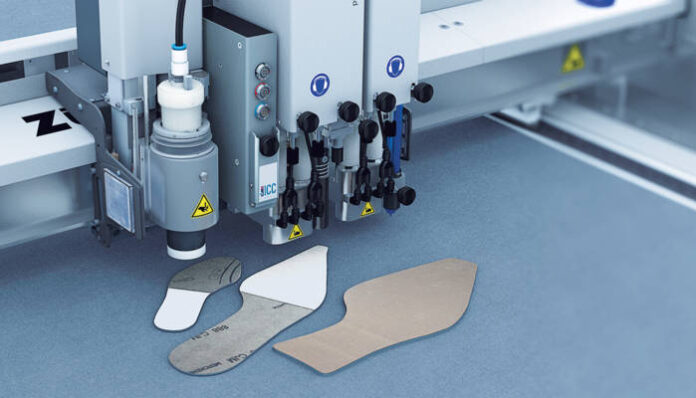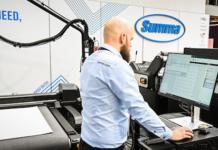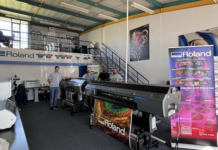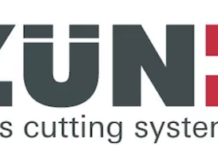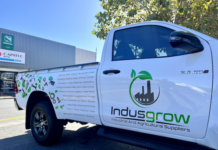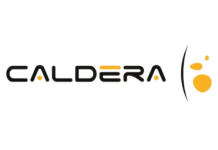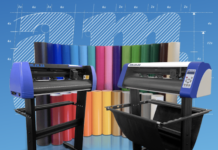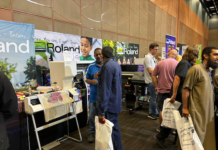German shoe manufacturer Berkemann demonstrates that a combination of frugality, specialist knowledge and consummate skill in digitalising processes can propel German shoe manufacturers to the very top. The company has been working to digitalise its cutting departments and relies on digital cutting technology and software from Zünd.
For Christoph Kannengiesser, Head of Technical Projects, comfort is also about ‘listening to one another, being aware of customer needs and constantly being alert to opportunities for further improvement’.
Berkemann has four production plants in Hungary alone, ‘In Hungary, the land of shoemakers and the renowned Budapest-style shoes, we manufacture comfortable shoes using the craftsmanship and expertise of our specialists. Manufacturing our footwear in the heart of Europe allows us to respond quickly to market requirements, while keeping our delivery routes short and supply chains transparent,’ explained Managing Director Thomas Bauerfeind at a recent event to mark the 25th anniversary of Berkemann Hungary.
Sustainability is a key area of focus at Berkemann and permeates everything related to production. At the end of the day, however, it needs to make economic sense. As Kannengiesser said, ‘This is a key area of our investment in Hungary. Substituting the strip steel previously used for the cutting dies was an important element in our efforts to digitalise the cutting facility at our plant in Kiskunfélegyháza in Hungary.’
However, digitalising the leather qualification process was an even more pressing concern in the evaluation phase, as only digital evaluation and measurement of leather hides make the subsequent process steps repeatable.
Berkemann has been using nesting processes for a long time. Another criterion for the decision was that nesting with the new Mind software had to be at least as good as the current solution, and preferably even better. ‘In most cases, Mind nesting has made us more efficient today. We can nest the cut parts more effectively on a hide that has been digitally recorded and qualitatively evaluated beforehand,’ explained Kannengiesser.
Kannengiesser is especially effusive when discussion moves on to the digitalised evaluation of leather hides. Berkemann has invested in two MindCUT Diva systems. ‘Diva’ stands for Digital Inspection and Virtual Annotation. Employees who had to be redeployed elsewhere after the swivel-arm cutting presses were replaced by Zünd cutters can now qualify a whole skin on the Diva systems in less than five minutes.
‘To use a Diva, I still need skilled staff who know our collection and are familiar with different qualities of leather and directions of pull. These people know exactly which pattern piece they can place how deep into the shank areas.’
Another key task is checking whether the quality and quantity of leather delivered corresponds to what has been ordered. According to Kannengiesser, what was once almost impossible has now become routine: ‘The Diva allows me to photo-optically document and measure any skin. It’s an elegant solution that helps prevent under-deliveries. If we order 500m, we’d be happy to receive 505m, but certainly not 490m. And if I’m ordering a premium product, I want to make sure that’s what I’m paying for. MindCUT Diva offers us a powerful tool that does just that. It makes us much more efficient, while enabling us to keep a very close eye on our leather suppliers.’
By introducing these digital solutions, Berkemann is whipping up enthusiasm for working in the cutting shop among the younger, computer-savvy generation. They prefer working on modern, computer-controlled production systems rather than outdated swivel-arm cutting presses. For staff who had previously worked on the swivel-arm cutting presses, the transition to digital cutting was a big change. ‘We guided people through the process and gradually familiarised them with their tasks. We received excellent support from Zünd along the way.’
Digitalised cutting offers vast savings potential. For one thing, it does away with the need for punching knives. ‘Now that we no longer need punching knives, we’ve been able to shorten our internal processes by several weeks. We no longer have to wait for the punching knives, spend time setting them up, and so on. Once the CAD data is created and we have the pattern ready, we can go straight to production. A whole slew of additional tasks and communication is no longer needed. Previously, if we were making a shoe model in different materials we would have to order up to three different sets of punching knives. Today, we can do all this virtually and make quick or last-minute changes without having to pay for tools that aren’t needed or wasting any time.’
One special feature of Berkemann’s production process is the scan-to-order workflow. This is an offline process in which the hide specifications and nesting of the cut pieces are digitalised via the MindCUT Diva recording system and Mind software, rather than being performed on the presses. After visiting customers, the sales representatives enter the orders on their laptops and transmit them to the head office in Thuringia. Orders are then bundled in the data processing center and forwarded to Purchasing and Supply Chain Management, which calculate the amount of material required.
The actual area calculations from the CAD system are supplemented by various additional factors. The various shoe parts are laid out on this gross area – provided they are made of the same material, of the same quality – and added up to give the amount of space required for the order.
Once the order quantity has been determined, production can begin. Berkemann only produces to order. The variety of models is vast, and an order for a particular item can sometimes be just 20 pairs. ‘In this case, it’s a matter of sample production, rather than custom industrial manufacture. We have to be able to work as flexibly and efficiently as possible. But there are other cases where we have higher volumes of up to 2000 pairs of one article, such as a shoe model in a single colour, in 14 different sizes.’
The cutter then goes to the material store with their leather pad, scans the orders and gathers the materials accordingly. At the same time, the cutting job is being prepared on the cutter. All the operator has to do is double click to confirm, place the hide, which has previously been given a barcode, on the table, align it, click on the markings and get started on the cutting. ‘The barcode, which I also scan with the cutter, tells me which hide I have in front of me, so the nesting is sorted automatically. In other words, it’s a foolproof process that eliminates error. It ensures a very high level of repeat accuracy.’
The scan-to-order workflow has made Berkemann much more flexible. The ability to nest different models on the same material has made the company’s operations even more effective, too. All of this is based on existing CAD data that is provided for nesting via the Model Importer. To ensure that you can maintain an overview after cutting, the cut parts are illuminated in different colours.
|
LOCAL DISTRIBUTOR |


